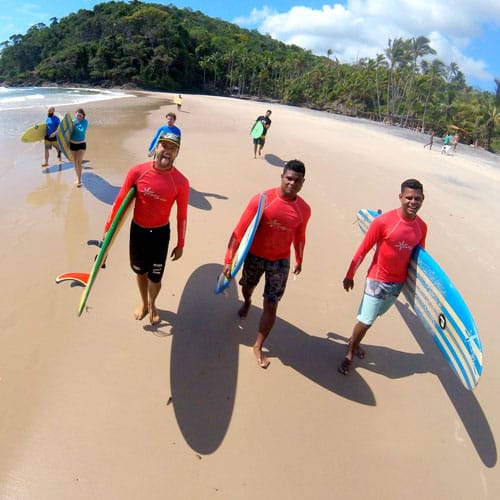Teaching Surfing

Our mission is to provide the maximum surf success through our courses of 4 lessons or more, with 100% safety and 200% fun.
To achieve this mission, we analyze the principal questions involved in the process of learning to surf, and we create our program with the goal of solving them.
1st Challenge
Little time standing up on the board
The main obstacle for learning to surf quickly is the extremely short amount of time that the surfer spends actually surfing, compared to the time he spends waiting for the waves…
The ratio between the time standing up versus the time waiting and paddling for a professional surfer, in perfect conditions and without a crowd, varies between 4% and 8%. Meanwhile for a novice surfer, trying to catch waves on the outside, that ratio is below 1% of time spent upright. In the end, there’s not a lot of time to practice the techniques…
2nd Challenge
Complex motor coordination
Surfing involves complex motor skills. The majority of the body movements used in our sport are completely strange for the “normal” human body, used for walking and moving on the ground and not in the water… This is especially true of paddling, but also of the skill of staying upright on the board and turning it.
Because of this, beginners, particularly adults, when trying to learn to surf by themselves, generally build bad habits by doing the wrong movements, which prevents them from progressing in surfing and achieving a level where the sport starts to bring a lot of pleasure: long rides, speed and carves.
3rd Challenge
Exercise for the Brain
The waves change form and characteristics every moment, a surfer needs to be able to react and apply multiple techniques with agility to maximize a wave.
Because many things happen at the same time and so quickly, the beginner surfer’s reactions have to become automatic, until he/she acts on instinct rather than consciously, preventing him/her from trying something new while catching a wave.
Our solutions
EasyDrop developed its instructional surf program with a focus on the questions above and how to answer them.
We carefully analyzed all the techniques involved in the practice of surfing, and then we broke them into simple steps that are easy to practice and learn. Initially, we taught these steps independently and in the correct didactic order.
Whenever possible, we first teach each new technique on land, just with the body movements. Then, these techniques are practiced on longboards in the whitewater, where there you spend more time actually surfing than you would further out. And once you feel comfortable with these skills on the inside (whitewater) we’ll take you to practice on the outside, where you can apply the skills you learned before, with the rhythm of the wave, and surfing consciously.
The use of technology is an important tool that helps with faster learning. All of the lessons from Monday to Friday are filmed. After the surf sessions, there is a surf theory class with the analysis and detailed review of the waves that the class surfed. The visualization of the session helps more quickly assimilate the points that need to be improved. Based on the video, instructors define individual objectives for each student to focus on the next day.
But the key to success in learning to surf with us is without a doubt our team of instructors, who have impeccable technical credentials and a lot of experience accumulated over the years. Our EasyDrop instructors possess certification from Surfing Australia Inc, are CBS (Brazilian Confederation of surf) certified surf judges, and have first aid training.They know what they’re talking about and are ready to show you how to act on the water and how to stay safe.

